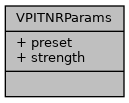Performs temporal noise reduction in a sequence of images. More...
Data Structures | |
| struct | VPITNRParams |
| Structure that defines the parameters for vpiSubmitTemporalNoiseReduction. More... | |
Enumerations | |
| enum | VPITNRPreset |
| Defines scene presets for temporal noise reduction. More... | |
| enum | VPITNRVersion |
| Defines the version of the Temporal Noise Reduction algorithm to be used. More... | |
Functions | |
| VPIStatus | vpiCreateTemporalNoiseReduction (uint32_t backends, int32_t width, int32_t height, VPIImageFormat imgFormat, VPITNRVersion version, VPIPayload *payload) |
| Creates a payload for Temporal Noise Reduction algorithm. More... | |
| VPIStatus | vpiInitTemporalNoiseReductionParams (VPITNRParams *params) |
| Initializes vpiSubmitTemporalNoiseReduction with default values. More... | |
| VPIStatus | vpiSubmitTemporalNoiseReduction (VPIStream stream, uint32_t backend, VPIPayload payload, VPIImage prevFrame, VPIImage curFrame, VPIImage outFrame, const VPITNRParams *params) |
| Submits a Temporal Noise Reduction operation to the stream associated with the given payload. More... | |
Detailed Description
Performs temporal noise reduction in a sequence of images.
Data Structure Documentation
◆ VPITNRParams
| struct VPITNRParams |
Structure that defines the parameters for vpiSubmitTemporalNoiseReduction.
Definition at line 132 of file TemporalNoiseReduction.h.
 Collaboration diagram for VPITNRParams:
Collaboration diagram for VPITNRParams:| Data Fields | ||
|---|---|---|
| VPITNRPreset | preset | Scene preset to be used. |
| float | strength |
Noise reduction strength. It's a floating point value between 0 and 1, inclusive. |
Enumeration Type Documentation
◆ VPITNRPreset
| enum VPITNRPreset |
#include <vpi/algo/TemporalNoiseReduction.h>
Defines scene presets for temporal noise reduction.
These presets are used by Temporal Noise Reduction to define its internal parameters suitable for noise reduction of scenes captured with given characteristics.
Definition at line 82 of file TemporalNoiseReduction.h.
◆ VPITNRVersion
| enum VPITNRVersion |
#include <vpi/algo/TemporalNoiseReduction.h>
Defines the version of the Temporal Noise Reduction algorithm to be used.
Higher version numbers usually achieve better quality. Some versions might not be available for a given device/backend.
Definition at line 97 of file TemporalNoiseReduction.h.
Function Documentation
◆ vpiCreateTemporalNoiseReduction()
| VPIStatus vpiCreateTemporalNoiseReduction | ( | uint32_t | backends, |
| int32_t | width, | ||
| int32_t | height, | ||
| VPIImageFormat | imgFormat, | ||
| VPITNRVersion | version, | ||
| VPIPayload * | payload | ||
| ) |
#include <vpi/algo/TemporalNoiseReduction.h>
Creates a payload for Temporal Noise Reduction algorithm.
This function allocates all resources needed by the algorithm and ties the returned payload to the given backend.
- Parameters
-
[in] backends VPI backends that are eligible to execute the algorithm. Currently only one backend is accepted. [in] width,height Dimensions of frames to be processed. [in] imgFormat Format of the images to be processed. [in] version Version of the algorithm to be used. [out] payload Pointer to memory where the created payload handle will be written to.
- Returns
- VPI_SUCCESS if payload was created successfully, or some other VPIStatus value in case of error.
◆ vpiInitTemporalNoiseReductionParams()
| VPIStatus vpiInitTemporalNoiseReductionParams | ( | VPITNRParams * | params | ) |
#include <vpi/algo/TemporalNoiseReduction.h>
Initializes vpiSubmitTemporalNoiseReduction with default values.
Defaults:
- preset: VPI_TNR_PRESET_DEFAULT
- strength: 0.5
- Parameters
-
[in] params Structure to be filled with default values.
- Returns
- an error code on failure else VPI_SUCCESS
◆ vpiSubmitTemporalNoiseReduction()
| VPIStatus vpiSubmitTemporalNoiseReduction | ( | VPIStream | stream, |
| uint32_t | backend, | ||
| VPIPayload | payload, | ||
| VPIImage | prevFrame, | ||
| VPIImage | curFrame, | ||
| VPIImage | outFrame, | ||
| const VPITNRParams * | params | ||
| ) |
#include <vpi/algo/TemporalNoiseReduction.h>
Submits a Temporal Noise Reduction operation to the stream associated with the given payload.
- Parameters
-
[in] stream The stream where the operation will be queued in. [in] backend Backend that will execute the algorithm. Must be one of the backends specified during payload creation. If 0, VPI will select one of the eligible backends from the payload that accepts the given parameters, usually the fastest one. [in] payload Payload to be submitted along the other parameters. [in] prevFrame When processing the first frame of a video sequence, this must be NULL. For subsequent frames, user must pass the result of the previous run of the algorithm. [in] curFrame Current frame to be processed. [out] outFrame Output frame, where de-noised image will be written to. [in] params Control parameters for temporal noise reduction. If NULL, it'll use the defaults given by vpiInitTemporalNoiseReductionParams.
- Returns
- VPI_SUCCESS if algorithm was submitted successfully, or some other VPIStatus value in case of error. Some errors will only be reported asynchronously by synchronization functions or subsequent algorithm submissions.
